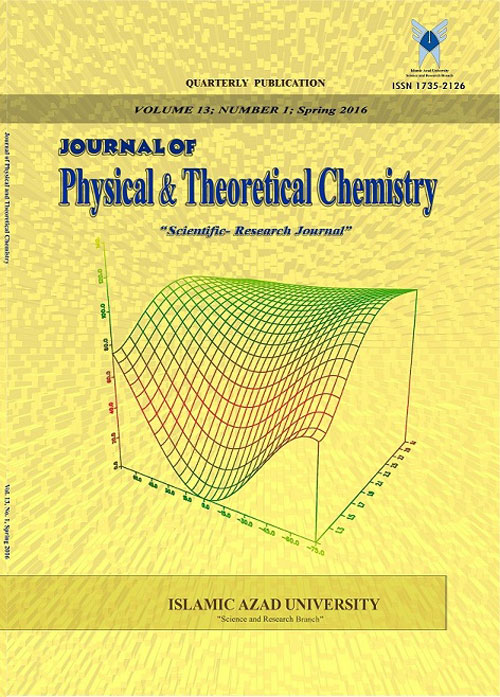فهرست مطالب

Journal of Physical and Theoretical Chemistry
Volume:4 Issue: 2, Summer 2007
- تاریخ انتشار: 1386/05/10
- تعداد عناوین: 7
-
Pages 3-8The dependence on ionic strength of protonation of methionine and its complexation with dioxovanadium(V) isreported in sodium perchlorate solution as supporting electrolyte. The measurements have been performed at 25C using a combination of potentiometric and spectrophotometric techniques. The overall analysis of the presentand the previous data dealing with determination of stability constants at different ionic strengths allowed us toobtain a general equation, by which a formation constant determined at a fixed ionic strength can berecalculated, with a good approximation for another ionic strength in the range of 0.1 – 0.7 mol dm-3.Keywords: Ionic strength, Formation constant, Methionine, Dioxovanadium(V)
-
Pages 9-16The electrocoagulation (EC) is a simple and efficient method for the treatment of many water and wastewaters.The kinetics of decolorization of Acid Yellow 23 by EC using iron electrodes was studied. Theelectrodecolorization rate follows pseudo-first order kinetic with respect to the AY23 concentration havingkapp= 5.65 cm min-1 at T= 295 K. The rate equation is as follows:ln [AY23]t – ln [AY23]0 = -kapp2336 cm t250 cmThe pseudo-first order rate constant (kapp) is sensitive to the operational parameters. The kapp is low in bothhighly acidic and basic conditions. For the optimum operating conditions in electrodecolorization of AY23, theactivation energy was 41.15 kJ mol-1, sludge volume was about 8 ml from 250 ml of the original AY23 solution.The electrical energy consumption required for this treatment was 7.74 × 10-4 kW h and the electrodeconsumption was 37.4 mg.Keywords: Electrodecolorization, Electrocoagulation, Kinetic, Acid Yellow 23, Tartrazine, Iron electrode
-
Pages 17-28Ab initio and DFT methods have been used to study the seven tautomeric forms of 5-methylcytosine molecule.The related tautomer in gas phase have been studied at HF/6-31G, HF/6-31G* and B3LYP/6-31G* levels oftheory. The structures,enthalpies,entropies,Gibbs free energies,relative tautomerization energies of tautomersand tautomeric equilibrium constants were compared and analyzed along with full geometry optimization. Thecalculations showed that the Oxo-amino(6), Oxo-imino(7) and Hydroxy-amino(4) tautomers are the most stablein the gas phase. The results are in a good agreement with the available experimental data. The entropy effecton the Gibbs free energy of the 5-methylcytosine bases is very small and it has a little significance on thetautomeric equilibria of pyrimidine bases.Therefore the enthalpic term is dominant in the determination of theequilibrium constants. 13C-NMR studies have been carried out for these tautomers and the results arediscussed.We have also evaluated the hybridation coefficient for bonds and hetero atom LPS in the aromaticring for the stable tautomers. Natural Bond Orbital Theory (NBO) calculation showed that the stable tautomersmust be considered aromatic.Keywords: 5-methylcytosine, Tautomerism, Tautomeric equilibrium constant, NBO, 13C-NMR, chemical shift, Abinitio, DFT
-
Pages 29-38Hydrogen bonding of DPPE with water that surrounded of membrane, plays an important role in permeability ofmembrane that we were presented this matter with analysis of bond angles and torsion angles before and after ofadded water molecules.Interaction with water molecules causes some changes in the geometry of DPPE which were explained bythe contribution of zwitterionic form of DPPE molecule, also hydrated DPPE becomes stabilized. Comparisonbetween theoretical and experimental values of geometry of DPPE molecule calculations at HF/3-21G levelproduce results in better agreement with the crystallography structure. The NMR shielding tensor of selectedatoms in the hydrated complexes of DPPE were reported by ab initio level of theory.Keywords: Hydrogen bonding, DPPE, Zwitterionic
-
Pages 39-50Topological indices are the numerical value associated with chemical constitution purporting for correlation ofchemical structure with various physical properties, chemical reactivity or biological activity. Graph theory is adelightful playground for the exploration of proof techniques in Discrete Mathematics and its results haveapplications in many areas of sciences. One of the useful indices for examination of structure-proeprtyrelationship is Randić index. In this study, is represented the relationship between the Randić index and thedeterminants of the adjacency matrix to the Dewar resonance energy (DRE) of annulene compounds by usingab-initio calculations (B3LYP/6-31G*). The alternative double bonds and conjugation are one of the mainproperties in annulene compounds. DRE is the quantity which allows one to account for the effects of cyclicelectron delocalization and thus serves as a measure of the aromatic stabilization of an annulene molecularentity. For calculation the Dewar resonance energy (DRE) of the compounds could use the equation of DRE.The interesting results of concerning among DRE and the above indices are presented.Keywords: Molecular topology, Randić index, Annulene Compounds, Dewar resonance energy, Adjacencymatrix, Ab-initio calculation
-
Pages 51-56The interaction of DPPA which is an important component in cellular membrane with molecules of water asmedia, cause some changes in geometry of DPPA .In this study we focused our attention on comparing thismolecule with related hydrated complexes employing different basis sets at hartree-fock levels of theory. Thetheoretical NMR shielding tensor of some imported atoms were also reported.Keywords: Hydrogen bond, DPPA, NMR shielding
-
Pages 57-62The energy minima of systems made of an alanine molecule, a lithium cation and a various number of watermolecules have been determined with the help of quantum mechanical computations at the B3LYP DensityFunctional Theory level of computation and the standard 6-311++G (d,p) basis set. Several structures, close inenergy are found and the presence of one or two water molecules around the cation modifies the order ofstability. The results are discussed in view of better understanding the structure of aqueous solutions of thesespecies and the possible interactions of lithium cations with peptides.Keywords: DFT quantum mechanical computations, Lithium–alanine interactions, Hydration, Aqueous solution

